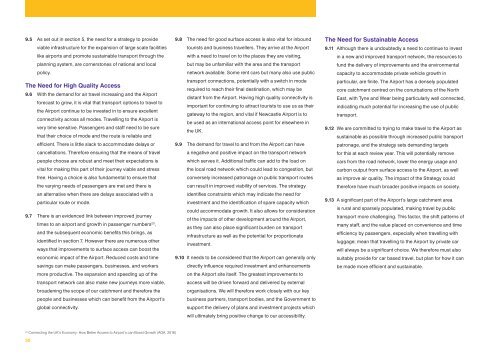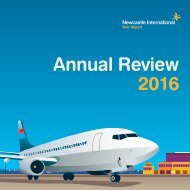Airport Masterplan 2035 LOW RES
Create successful ePaper yourself
Turn your PDF publications into a flip-book with our unique Google optimized e-Paper software.
<strong>Masterplan</strong> <strong>2035</strong><br />
9.5 As set out in section 5, the need for a strategy to provide<br />
viable infrastructure for the expansion of large scale facilities<br />
like airports and promote sustainable transport through the<br />
planning system, are cornerstones of national and local<br />
policy.<br />
The Need for High Quality Access<br />
9.6 With the demand for air travel increasing and the <strong>Airport</strong><br />
forecast to grow, it is vital that transport options to travel to<br />
the <strong>Airport</strong> continue to be invested in to ensure excellent<br />
connectivity across all modes. Travelling to the <strong>Airport</strong> is<br />
very time sensitive. Passengers and staff need to be sure<br />
that their choice of mode and the route is reliable and<br />
efficient. There is little slack to accommodate delays or<br />
cancellations. Therefore ensuring that the means of travel<br />
people choose are robust and meet their expectations is<br />
vital for making this part of their journey viable and stress<br />
free. Having a choice is also fundamental to ensure that<br />
the varying needs of passengers are met and there is<br />
an alternative when there are delays associated with a<br />
particular route or mode.<br />
9.7 There is an evidenced link between improved journey<br />
times to an airport and growth in passenger numbers 23 ,<br />
and the subsequent economic benefits this brings, as<br />
identified in section 7. However there are numerous other<br />
ways that improvements to surface access can boost the<br />
economic impact of the <strong>Airport</strong>. Reduced costs and time<br />
savings can make passengers, businesses, and workers<br />
more productive. The expansion and speeding up of the<br />
transport network can also make new journeys more viable,<br />
broadening the scope of our catchment and therefore the<br />
9.8 The need for good surface access is also vital for inbound<br />
tourists and business travellers. They arrive at the <strong>Airport</strong><br />
with a need to travel on to the places they are visiting,<br />
but may be unfamiliar with the area and the transport<br />
network available. Some rent cars but many also use public<br />
transport connections, potentially with a switch in mode<br />
required to reach their final destination, which may be<br />
distant from the <strong>Airport</strong>. Having high quality connectivity is<br />
important for continuing to attract tourists to use us as their<br />
gateway to the region, and vital if Newcastle <strong>Airport</strong> is to<br />
be used as an international access point for elsewhere in<br />
the UK.<br />
9.9 The demand for travel to and from the <strong>Airport</strong> can have<br />
a negative and positive impact on the transport network<br />
which serves it. Additional traffic can add to the load on<br />
the local road network which could lead to congestion, but<br />
conversely increased patronage on public transport routes<br />
can result in improved viability of services. The strategy<br />
identifies constraints which may indicate the need for<br />
investment and the identification of spare capacity which<br />
could accommodate growth. It also allows for consideration<br />
of the impacts of other development around the <strong>Airport</strong>,<br />
as they can also place significant burden on transport<br />
infrastructure as well as the potential for proportionate<br />
investment.<br />
9.10 It needs to be considered that the <strong>Airport</strong> can generally only<br />
directly influence required investment and enhancements<br />
on the <strong>Airport</strong> site itself. The greatest improvements to<br />
access will be driven forward and delivered by external<br />
organisations. We will therefore work closely with our key<br />
The Need for Sustainable Access<br />
9.11 Although there is undoubtedly a need to continue to invest<br />
in a new and improved transport network, the resources to<br />
fund the delivery of improvements and the environmental<br />
capacity to accommodate private vehicle growth in<br />
particular, are finite. The <strong>Airport</strong> has a densely populated<br />
core catchment centred on the conurbations of the North<br />
East, with Tyne and Wear being particularly well connected,<br />
indicating much potential for increasing the use of public<br />
transport.<br />
9.12 We are committed to trying to make travel to the <strong>Airport</strong> as<br />
sustainable as possible through increased public transport<br />
patronage, and the strategy sets demanding targets<br />
for this at each review year. This will potentially remove<br />
cars from the road network, lower the energy usage and<br />
carbon output from surface access to the <strong>Airport</strong>, as well<br />
as improve air quality. The impact of the Strategy could<br />
therefore have much broader positive impacts on society.<br />
9.13 A significant part of the <strong>Airport</strong>’s large catchment area<br />
is rural and sparsely populated, making travel by public<br />
transport more challenging. This factor, the shift patterns of<br />
many staff, and the value placed on convenience and time<br />
efficiency by passengers, especially when travelling with<br />
luggage; mean that travelling to the <strong>Airport</strong> by private car<br />
will always be a significant choice. We therefore must also<br />
suitably provide for car based travel, but plan for how it can<br />
be made more efficient and sustainable.<br />
Current Passenger and Staff Modal Split<br />
9.14 An online survey of passengers was undertaken in early<br />
2017, covering a broad demographic and place of origin,<br />
and showed the passenger modal split shown in Figure 21.<br />
This shows that the majority of passengers (53%) travel to<br />
the <strong>Airport</strong> by private car, with a further 30% using taxis, and<br />
1% travelling by hire car. Collectively this means that 86% of<br />
passengers arrived or departed the <strong>Airport</strong> by car. Around<br />
14% utilised public transport, with the Metro being by far the<br />
most popular mode.<br />
Figure 21 – Passenger Modal Split 2017<br />
2% 1%<br />
12%<br />
53%<br />
30%<br />
9.15 Numerous reasons were given as to why sustainable modes<br />
weren’t considered for the journey, which included the<br />
convenience of private transport and the lack of options<br />
and time demand for public transport for longer trips.<br />
This in part can be explained by the <strong>Airport</strong>’s dispersed<br />
regional catchment, with the use private car much greater<br />
for passengers travelling from outside Tyne and Wear.<br />
Figure 22 shows the distribution of passenger home<br />
addressees who responded to the survey.<br />
Figure 22 – Origin of Passenger Survey<br />
Respondents 2017<br />
Glasgow<br />
Stirling<br />
Perth<br />
Dundee<br />
Edinburgh<br />
Carlisle<br />
Lancaster<br />
Preston<br />
Aberdeen<br />
Newcastle<br />
Durham<br />
Middlesbrough<br />
Ripon<br />
Leeds<br />
Wakefield<br />
York<br />
Kingston<br />
upon Hull<br />
9.16 Although it shows the wide dispersion of the <strong>Airport</strong>’s<br />
passenger base, it also indicates that the greatest<br />
concentration is in Tyne and Wear (69% of respondents<br />
were from NE postcodes) and so there is much potential for<br />
localised initiatives to increase use of sustainable transport<br />
to be effective.<br />
9.17 A survey of staff working on the <strong>Airport</strong> site was also<br />
undertaken in early 2017 and indicated the following modal<br />
split for commuting.<br />
Figure 23 – Staff Modal Split 2017<br />
1% 2%<br />
4%<br />
7%<br />
85%<br />
people and businesses which can benefit from the <strong>Airport</strong>’s<br />
global connectivity.<br />
business partners, transport bodies, and the Government to<br />
support the delivery of plans and investment projects which<br />
will ultimately bring positive change to our accessibility.<br />
Private Car 53% Taxi/Uber 30% Metro 12%<br />
Minibus / Private Bus / Coach 2%<br />
Hire Car 1% Public Bus 1% Other 1%<br />
Bangor<br />
Liverpool<br />
Chester<br />
Manchester<br />
Stoke-On-Trent<br />
Sheffield<br />
Nottingham<br />
Lincoln<br />
Car 85% Car Share 7% Metro 4%<br />
Bus 1% Cycle 1% Walk 2%<br />
23<br />
Connecting the UK’s Economy: How Better Access to <strong>Airport</strong>’s can Boost Growth (AOA, 2016)<br />
50<br />
51




